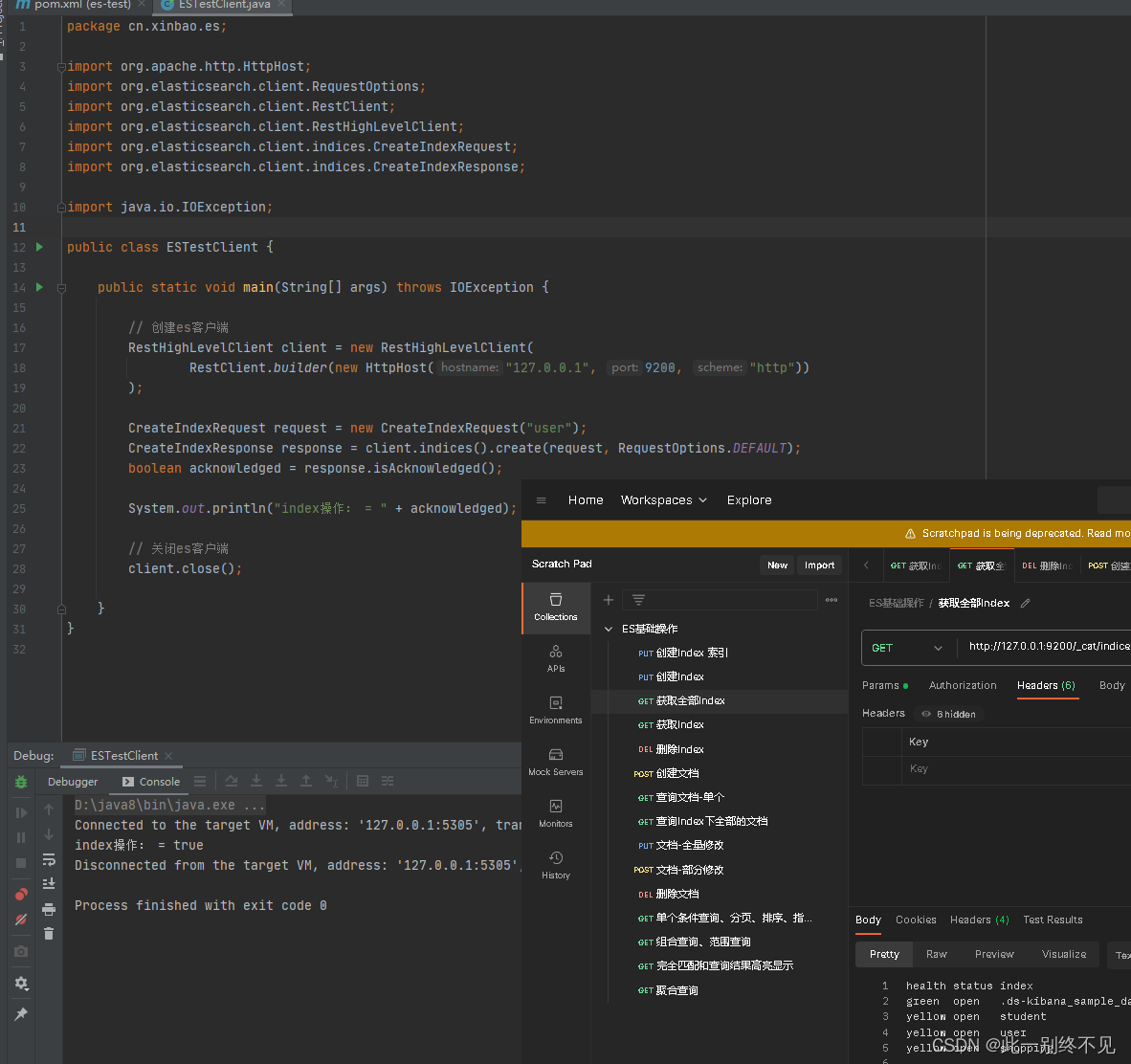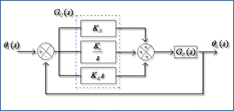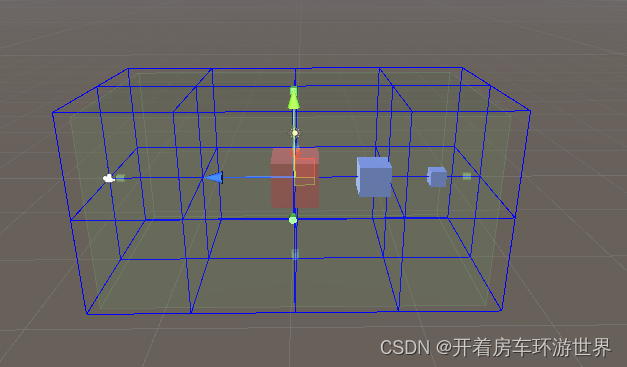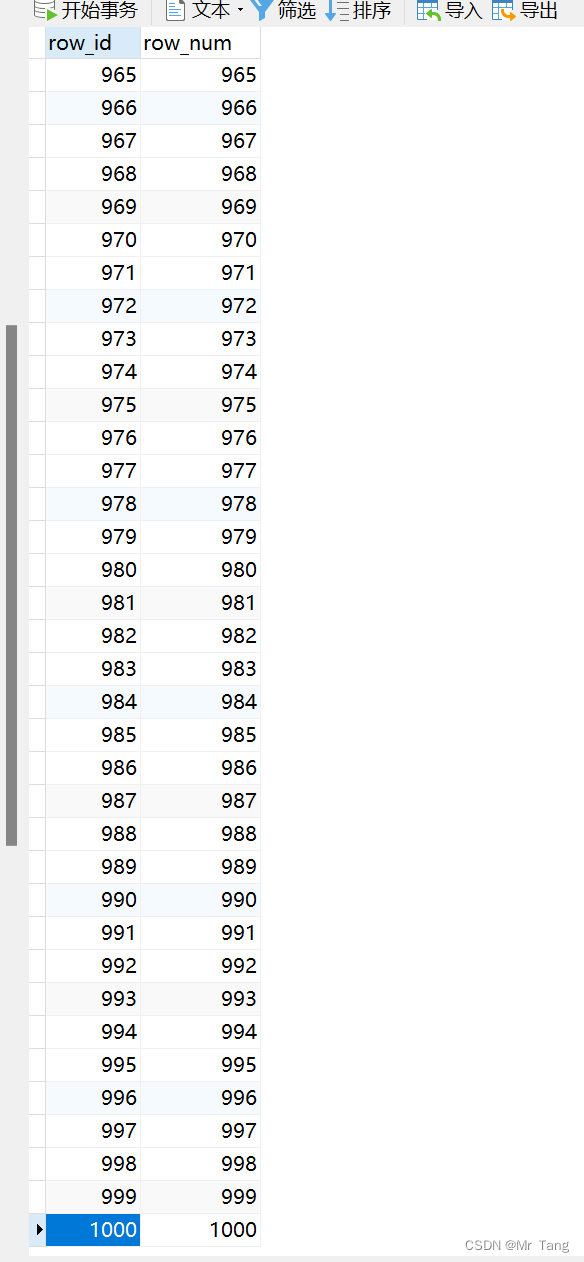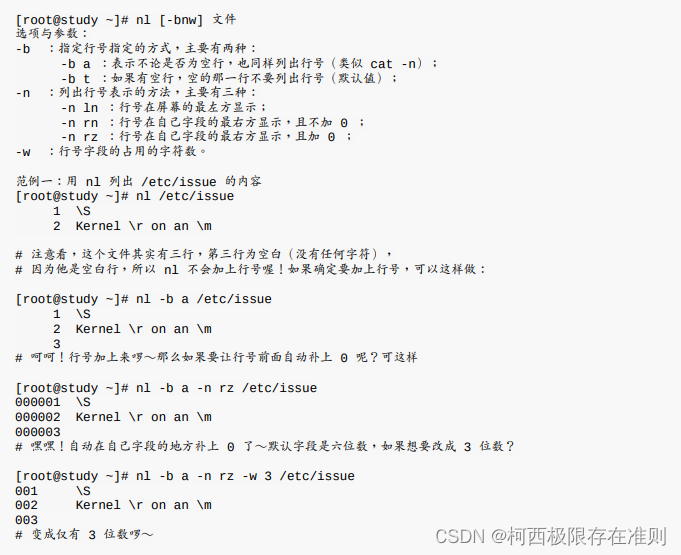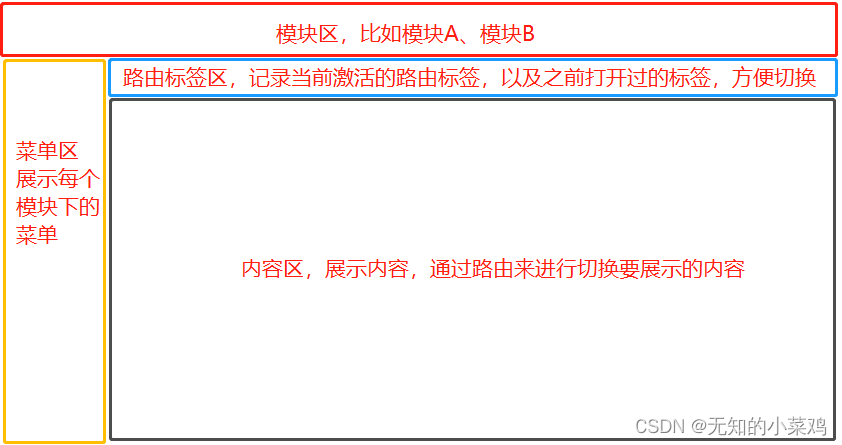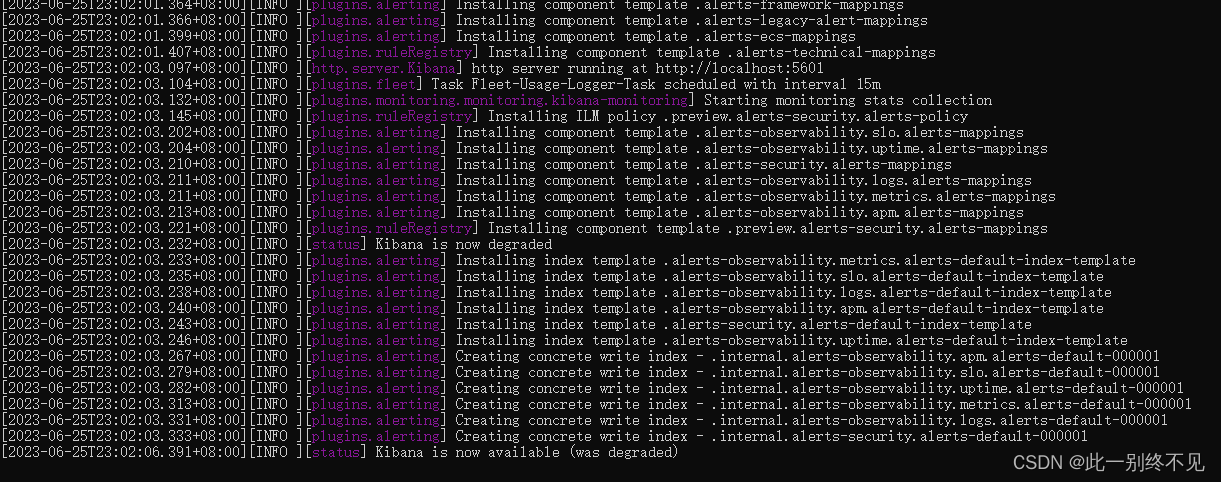MIT 6.830数据库系统 -- lab two
- 项目拉取
- Lab Two
- 实现提示
- 练习一 -- Filter and Join
- 练习二 -- Aggregates
- 练习三 -- HeapFile Mutability
- 练习四 -- Insertion & deletion
- 练习五 -- Page eviction
- 练习六 -- Query walkthrough
- 练习七 - 查询解析
项目拉取
原项目使用ant进行项目构建,我已经更改为Maven构建,大家直接拉取我改好后的项目即可:
- https://gitee.com/DaHuYuXiXi/simple-db-hw-2021
然后就是正常的maven项目配置,启动即可。各个lab的实现,会放在lab/分支下。
Lab Two
lab2必须在lab1提交的代码基础上进行开发,否则无法完成相应的练习。此外,实验还提供了源码中不存在的额外测试文件。
实现提示
开始编写代码之前,强烈建议通读整篇文档,以对SimpleDB的设计有个整体的认识,对于我们编写代码非常有帮助
建议跟着文档的练习来实现对应的代码,每个练习都标明了要实现哪个类以及通过哪些单元测试,跟着练习走即可。
下面是本实验的大致流程:
- 实现Filter和Join操作并且通过相关的单元测试验证你的实现,阅读类的Javadoc将会帮助我们实现。项目中已经提供了Project和OrderBy操作的实现,阅读其代码能够帮助我们理解其他操作是如何实现的
- 实现IntegerAggregator和StringAggregator,你将会编写对元组的某一特定列分组进行聚合操作;其中integer支持求和、求最大最小值、求数量、求平均值,string只支持count聚合操作
- 实现Aggregate操作;同其他操作一样,聚合操作也实现类OpIterator接口。注意每次调用next()的Aggregate操作的输出是整个分组的聚合值,Aggregate构造函数将会设置聚合和分组操作对应的列
- 实现BufferPool类中的插入、删除和页面丢弃策略,暂时不需要关心事务
- 实现Insert和Delete操作;与所有的操作相似,Insert和Delete实现OpIterator接口,接收用于插入或者删除的元组并输出该操作影响的元组个数;这些操作将会调用BufferPool中合适的方法用于修改磁盘上的页
注意SimpleDB没有实现一致性和完整性检查,所以它可能会插入重复的记录,并且没有方法保证主键或外键的一致性。
在本节实现的基础上,我们需要使用项目提供的SQL解析器去运行SQL语句查询。
最后,你可能会发现本实验的操作扩展Operator类而不是实现OpIterator接口。因为next/hasNext的实现总是重复的、烦人的,Operator实现了通用的逻辑操作,并且仅需要实现readNext方法。可以随意使用这种风格,或者使用OpIterator。如果要实现OpIterator接口,请移除extends Operator,并替换为implements OpIterator。
练习一 – Filter and Join
Filter and Join:
本节将会实现比扫描整张表更有趣的操作:
- Filter:该操作仅返回满足(构造时指定的)Predicate操作的元组;因此,它会过滤那些不符合操作的元组
- Join:该操作将会通过(构造时指定的)JoinPredicate联合两个表的元组,Join操作仅需实现一个简单的嵌套循环连接
实现如下类中的方法:
- src/java/simpledb/execution/Predicate.java
- src/java/simpledb/execution/JoinPredicate.java
- src/java/simpledb/execution/Filter.java
- src/java/simpledb/execution/Join.java
Predict和JoinPredict分别负责普通的断言和Join断言的操作:
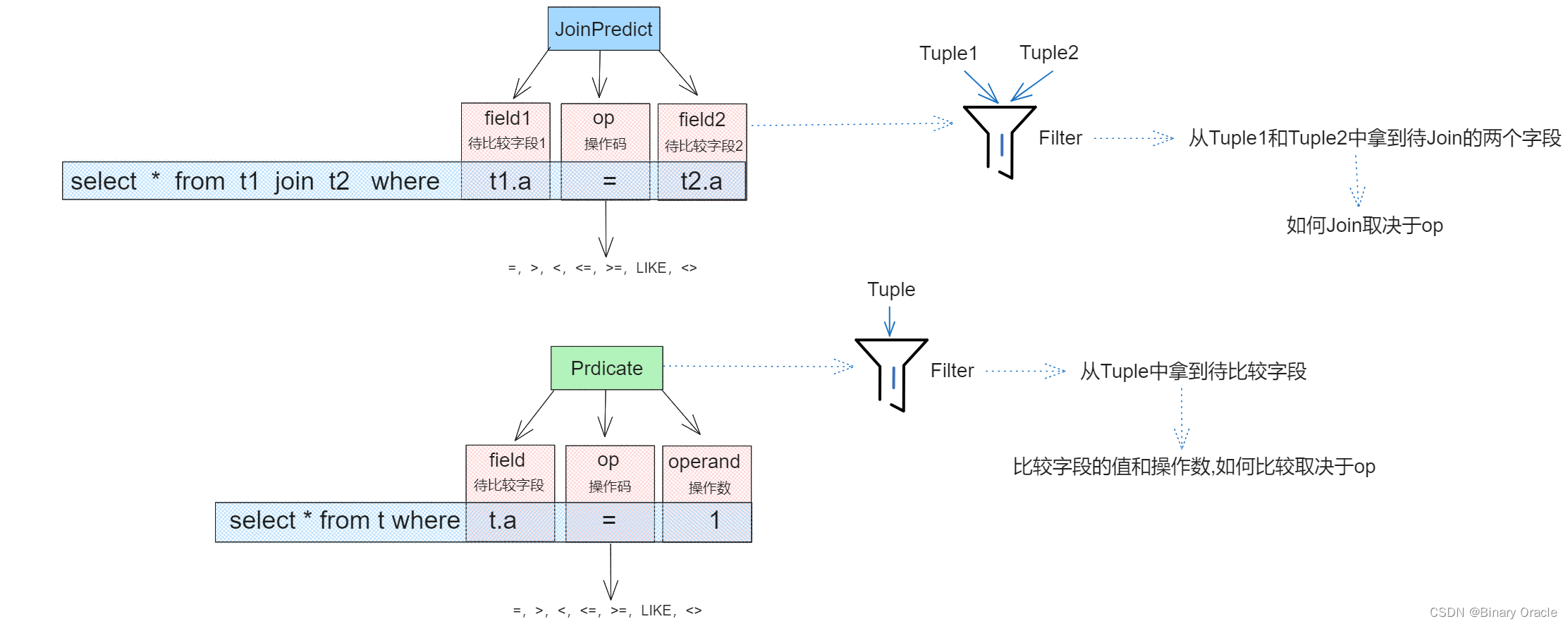
Predict类核心源码如下:
/**
* Predicate compares tuples to a specified Field value.
* 比较元组某个特定的字段--> select * from t where t.a=1;
*/
public class Predicate implements Serializable {
private static final long serialVersionUID = 1L;
/**
* 待比较字段
*/
private final int field;
/**
* 操作码
*/
private final Op op;
/**
* 操作数
*/
private final Field operand;
/**
* Constants used for return codes in Field.compare
*/
public enum Op implements Serializable {
EQUALS, GREATER_THAN, LESS_THAN, LESS_THAN_OR_EQ, GREATER_THAN_OR_EQ, LIKE, NOT_EQUALS;
/**
* Interface to access operations by integer value for command-line
* convenience.
*/
public static Op getOp(int i) {
return values()[i];
}
public String toString() {
if (this == EQUALS)
return "=";
if (this == GREATER_THAN)
return ">";
if (this == LESS_THAN)
return "<";
if (this == LESS_THAN_OR_EQ)
return "<=";
if (this == GREATER_THAN_OR_EQ)
return ">=";
if (this == LIKE)
return "LIKE";
if (this == NOT_EQUALS)
return "<>";
throw new IllegalStateException("impossible to reach here");
}
}
public Predicate(int field, Op op, Field operand) {
this.field = field;
this.op = op;
this.operand = operand;
}
/**
* Compares the field number of t specified in the constructor to the
* operand field specified in the constructor using the operator specific in
* the constructor. The comparison can be made through Field's compare
* method.
*/
public boolean filter(Tuple t) {
if (t == null) {
return false;
}
Field f = t.getField(this.field);
return f.compare(this.op, this.operand);
}
. . .
}
JoinPredict类核心源码如下:
/**
* JoinPredicate compares fields of two tuples using a predicate. JoinPredicate
* is most likely used by the Join operator.
* 用于JOIN连接断言的两个元组的某个字段 --> select * from t1 join t2 on t1.id=t2.id;
*/
public class JoinPredicate implements Serializable {
private static final long serialVersionUID = 1L;
/**
* 字段1
*/
private final int field1;
/**
* 操作码
*/
private final Predicate.Op op;
/**
* 字段2
*/
private final int field2;
public JoinPredicate(int field1, Predicate.Op op, int field2) {
this.field1 = field1;
this.op = op;
this.field2 = field2;
}
/**
* Apply the predicate to the two specified tuples. The comparison can be
* made through Field's compare method.
*/
public boolean filter(Tuple t1, Tuple t2) {
if (t1 == null) {
return false;
}
if (t2 == null) {
return false;
}
Field first = t1.getField(field1);
Field second = t2.getField(field2);
return first.compare(this.op, second);
}
...
}
OpIterator意为可操作迭代器,在SimpleDB中的含义为: 迭代器遍历元素的时候可以同时进行一些操作,具体遍历时执行什么操作由子类决定。

操作迭代器意味着迭代器自身在遍历数据时,会根据自身实现搞点事情,Operator接口模板化了部分流程,各个需要在迭代器遍历时进行操作的子类,只需要去实现readNext这个核心方法,并且每次获取下一个元组的时候,搞点事情即可。
这里不是说子类只需要去实现readNext方法,而是说readNext是子类需要实现的核心方法,其他均为辅助方法。
Operator类的核心源码如下:
/**
* Abstract class for implementing operators. It handles close, next and hasNext. Subclasses only need to implement open and readNext.
*/
public abstract class Operator implements OpIterator {
public boolean hasNext() throws DbException, TransactionAbortedException {
if (!this.open)
throw new IllegalStateException("Operator not yet open");
if (next == null)
next = fetchNext();
return next != null;
}
public Tuple next() throws DbException, TransactionAbortedException,
NoSuchElementException {
if (next == null) {
next = fetchNext();
if (next == null)
throw new NoSuchElementException();
}
Tuple result = next;
next = null;
return result;
}
protected abstract Tuple fetchNext() throws DbException,
TransactionAbortedException;
/**
* Closes this iterator. If overridden by a subclass, they should call
* super.close() in order for Operator's internal state to be consistent.
*/
public void close() {
// Ensures that a future call to next() will fail
next = null;
this.open = false;
}
private Tuple next = null;
private boolean open = false;
public void open() throws DbException, TransactionAbortedException {
this.open = true;
}
/**
* @return return the children DbIterators of this operator. If there is
* only one child, return an array of only one element. For join
* operators, the order of the children is not important. But they
* should be consistent among multiple calls.
* */
public abstract OpIterator[] getChildren();
/**
* Set the children(child) of this operator. If the operator has only one
* child, children[0] should be used. If the operator is a join, children[0]
* and children[1] should be used.
* */
public abstract void setChildren(OpIterator[] children);
/**
* @return return the TupleDesc of the output tuples of this operator
* */
public abstract TupleDesc getTupleDesc();
...
}
- 迭代器调用约定: 先调用hasNext判断是否还有下一个元素,如果有调用next获取下一个元素,并且调用hashNext前需要先调用Open。
- OpIterator操作迭代器分为两部分,一部分是原始职能: 提供数据进行迭代遍历; 另一部分是附加职能: 在原始迭代器遍历过程中进行操作。
- Operator采用装饰器模式封装原始迭代器遍历行为,并在其基础上增加了遍历时进行操作的行为。
- 装饰器模式需要有被装饰的对象,这里通过setChildren进行设置,但是这里与普通的装饰器模式不同,因为不同的操作会涉及到不同的个数的被装饰对象。
- select * from t where t.age=18 --> 此处实际使用了单值比较过滤操作,所以只涉及单表的迭代器
- select * from t1 join t2 on t1.age=t2.age --> 此时实际使用了两表JOIN操作,所以涉及两个表的迭代器
SimpleDB整个迭代器的设计思路采用了装饰器模式实现,具体如下图所示:
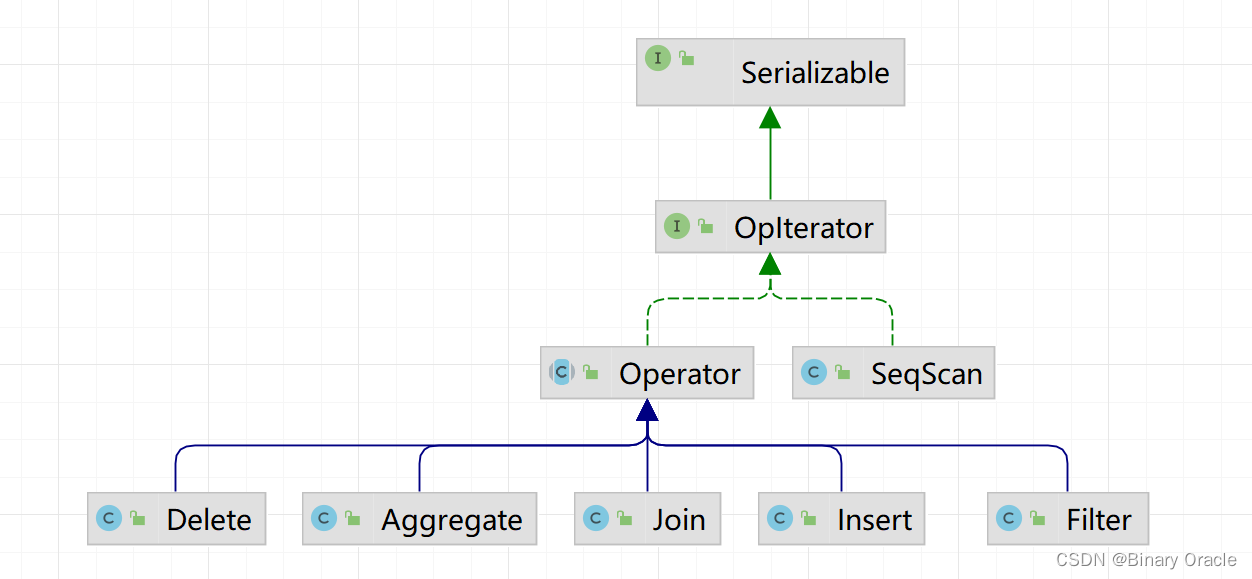
- Operator的实现类都是装饰器,而SeqScan是迭代器的实现,也就是被装饰的对象
迭代器模式的用法可以参考Java IO整体架构实现。
Filter用于单值比较操作,具体流程如下:
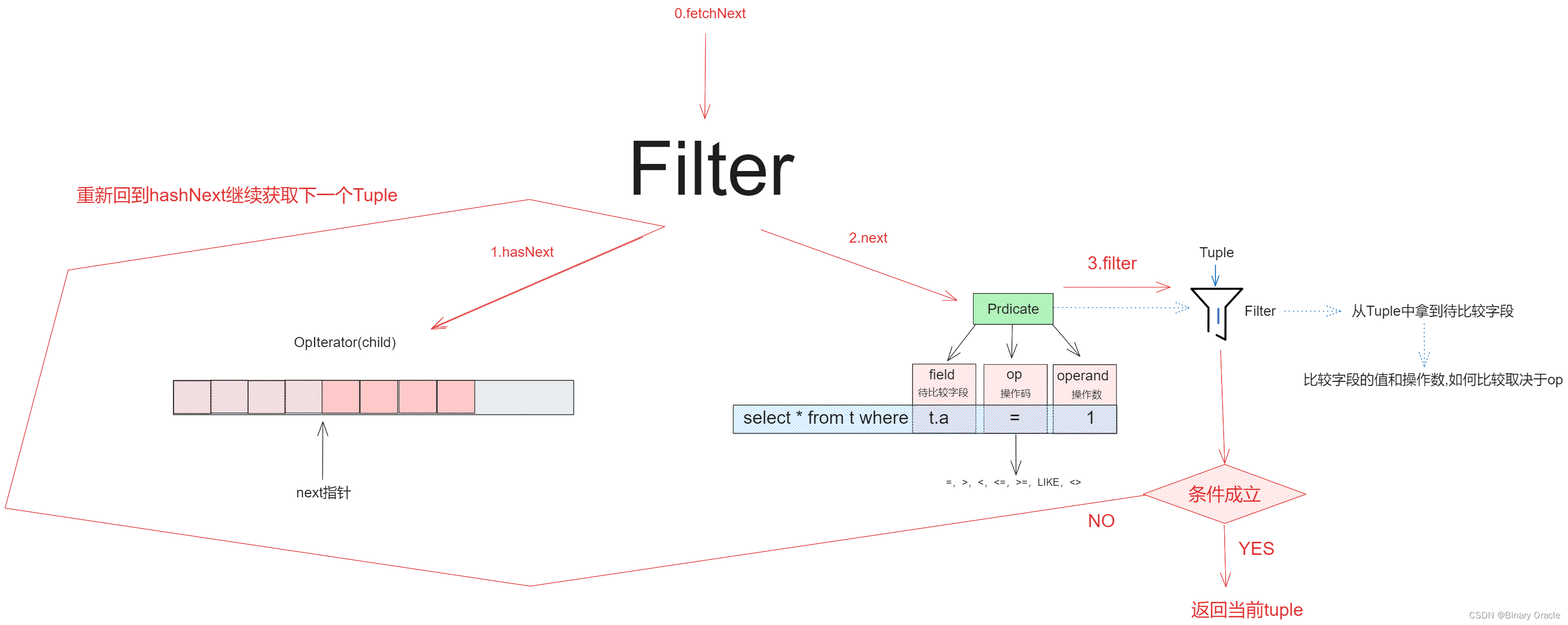
图中只展示的一层装饰,如果存在多层装饰,那么child仍然是个装饰器,可以利用多层装饰实现如: select * from t where t.age=18 and t.name="dhy"的匹配过滤。
Filter核心源码如下:
/**
* Filter is an operator that implements a relational select.
*/
public class Filter extends Operator {
private final Predicate predicate;
private OpIterator child;
/**
* Constructor accepts a predicate to apply and a child operator to read
* tuples to filter from.
*/
public Filter(Predicate p, OpIterator child) {
this.predicate = p;
this.child = child;
}
public void open() throws DbException, NoSuchElementException,
TransactionAbortedException {
super.open();
this.child.open();
}
public void close() {
this.child.close();
super.close();
}
public void rewind() throws DbException, TransactionAbortedException {
this.child.rewind();
}
/**
* AbstractDbIterator.readNext implementation. Iterates over tuples from the
* child operator, applying the predicate to them and returning those that
* pass the predicate (i.e. for which the Predicate.filter() returns true.)
*
*/
protected Tuple fetchNext() throws NoSuchElementException,
TransactionAbortedException, DbException {
while (this.child.hasNext()) {
Tuple tuple = this.child.next();
if (this.predicate.filter(tuple)) {
return tuple;
}
}
return null;
}
@Override
public OpIterator[] getChildren() {
return new OpIterator[] {this.child};
}
@Override
public void setChildren(OpIterator[] children) {
this.child = children[0];
}
...
}
Join用于连接条件判断,流程如下:
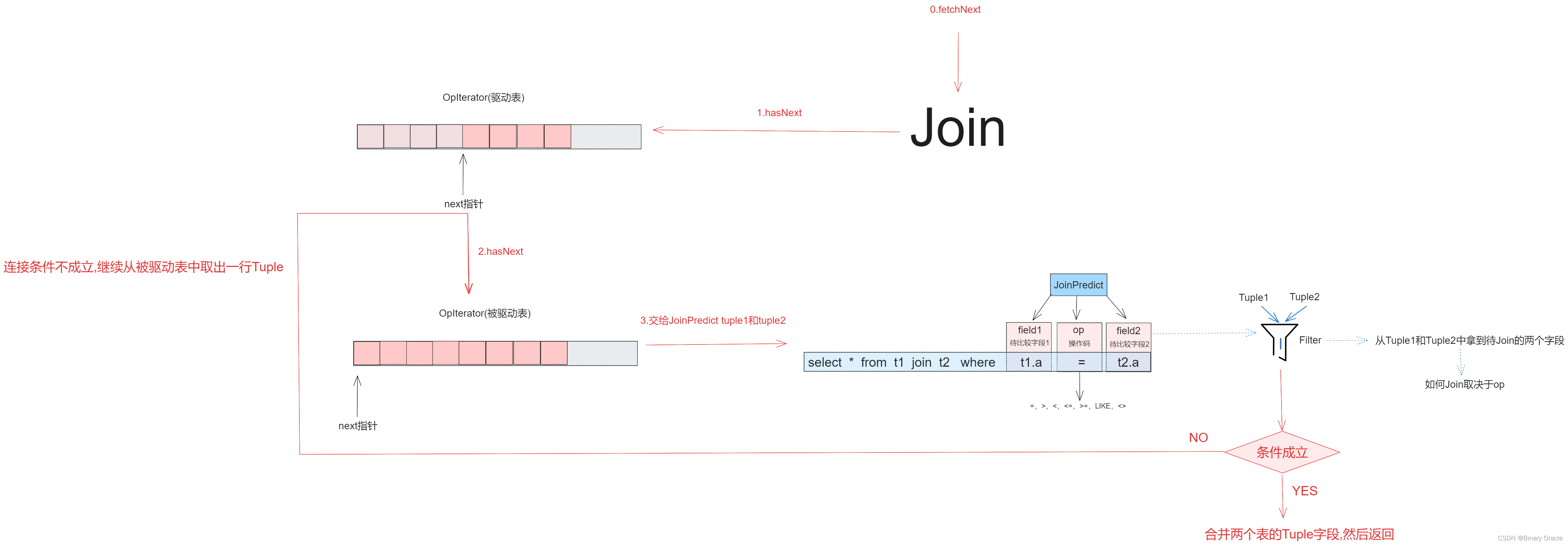
Join的核心源码如下:
/**
* The Join operator implements the relational join operation.
*/
public class Join extends Operator {
private static final long serialVersionUID = 1L;
/**
* 连接条件
*/
private final JoinPredicate predicate;
/**
* 参与连接的表
*/
private OpIterator[] children;
private Tuple tuple1;
/**
* Constructor. Accepts two children to join and the predicate to join them
* on
* @param p The predicate to use to join the children
* @param child1 Iterator for the left(outer) relation to join
* @param child2 Iterator for the right(inner) relation to join
*/
public Join(JoinPredicate p, OpIterator child1, OpIterator child2) {
this.predicate = p;
this.children = new OpIterator[]{child1, child2};
this.tuple1 = null;
}
/**
* 返回的是两表连接后得到结果的行schema
*/
public TupleDesc getTupleDesc() {
return TupleDesc.merge(this.children[0].getTupleDesc(), this.children[1].getTupleDesc());
}
public void open() throws DbException, NoSuchElementException,
TransactionAbortedException {
for (OpIterator child : this.children) {
child.open();
}
super.open();
}
public void close() {
for (OpIterator child : this.children) {
child.close();
}
super.close();
}
public void rewind() throws DbException, TransactionAbortedException {
for (OpIterator child : this.children) {
child.rewind();
}
}
/**
* Returns the next tuple generated by the join, or null if there are no
* more tuples. Logically, this is the next tuple in r1 cross r2 that
* satisfies the join predicate. There are many possible implementations;
* the simplest is a nested loops join.
* <p>
* Note that the tuples returned from this particular implementation of Join
* are simply the concatenation of joining tuples from the left and right
* relation. Therefore, if an equality predicate is used there will be two
* copies of the join attribute in the results. (Removing such duplicate
* columns can be done with an additional projection operator if needed.)
* <p>
* For example, if one tuple is {1,2,3} and the other tuple is {1,5,6},
* joined on equality of the first column, then this returns {1,2,3,1,5,6}.
*
* @return The next matching tuple.
* @see JoinPredicate#filter
*/
protected Tuple fetchNext() throws TransactionAbortedException, DbException {
// 双重循环,将children[0]作为驱动表,children[1]作为被驱动表
while (this.children[0].hasNext() || tuple1 != null) {
// 获取驱动表的一行记录
if (this.children[0].hasNext() && tuple1 == null) {
tuple1 = this.children[0].next();
}
// 获取被驱动表的一行记录
while (this.children[1].hasNext()) {
Tuple tuple2 = this.children[1].next();
// JoinPredicate判断join条件是否成立
if (this.predicate.filter(tuple1, tuple2)) {
// 获取驱动表schema和被驱动表schema合并后的schema
TupleDesc tupleDesc = getTupleDesc();
// 用于承载合并后的行记录
Tuple res = new Tuple(tupleDesc);
int i = 0;
// 拿到驱动表当前行的所有字段,然后设置到res
Iterator<Field> fields1 = tuple1.fields();
while (fields1.hasNext() && i < tupleDesc.numFields()) {
res.setField(i++, fields1.next());
}
// 拿到被驱动表当前行的所有字段,然后设置到res
Iterator<Field> fields2 = tuple2.fields();
while (fields2.hasNext() && i < tupleDesc.numFields()) {
res.setField(i++, fields2.next());
}
// 被驱动表遍历完了,重置指针,同时将tuple1也重置
if (!this.children[1].hasNext()) {
this.children[1].rewind();
tuple1 = null;
}
// 返回捞到的记录
return res;
}
}
// 驱动表当前行在被驱动表中没有匹配行,那么将被驱动表迭代指针复原
this.children[1].rewind();
tuple1 = null;
}
// 没有匹配记录
return null;
}
@Override
public OpIterator[] getChildren() {
return this.children;
}
@Override
public void setChildren(OpIterator[] children) {
this.children=children;
}
}
关于tuple1属性作用说明:
- 我们从驱动表中获取一条记录后,需要遍历被驱动表,在被驱动表中找出所有符合连接条件的行,然后拼接两表字段,然后返回结果
- fetchNext方法每调用一次,都会返回符合条件的一行记录,因此我们需要保留驱动表当前正在匹配的行,等到某一次fetchNext方法调用时,发现当前行与被驱动表每一行都进行了一次匹配后,才会从驱动表中取出下一行进行匹配。
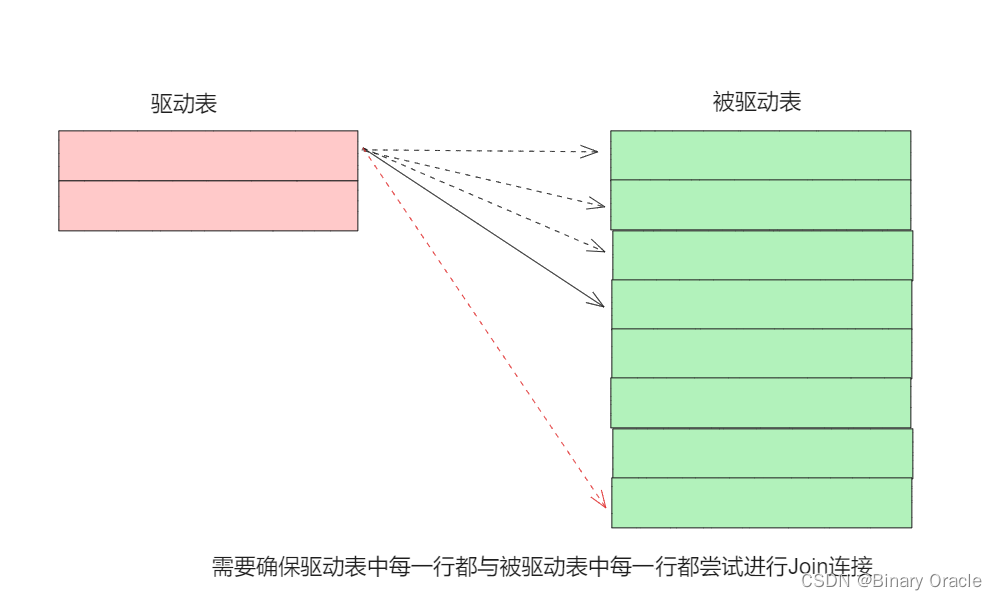
练习二 – Aggregates
Aggregates:
本节我们应该实现如下五种聚合操作:count、sum、avg、min、max,并且支持分组聚合操作。仅支持对一个域进行聚合,对一个域进行分组即可。
为了实现聚合操作,我们使用Aggregator接口将新的元组合并到现有的聚合操作结果中。实际进行哪种聚合操作会在构造Aggregate时指明。所以,客户端代码需要为子操作的每个元组调用Aggregator.mergeTupleIntoGroup()方法,当所有的元组都被合并完成以后,客户端将会获得聚合操作的结果。
- 如果指定分组的话,那么返回结果格式为: (groupValue, aggregateValue);
- 没有指定分组的话,返回格式为:(aggregateValue)
本节实验中,我们不需要担心分组的数量超过可用内存的限制。
实现如下类中的方法:
- src/java/simpledb/execution/IntegerAggregator.java
- src/java/simpledb/execution/StringAggregator.java
- src/java/simpledb/execution/Aggregate.java
Aggregator聚合器干的事情就是接收传入的Tuple,然后内部进行计算,当我们传入n个tuple后,我们可以调用聚合器的迭代器,获取当前聚合的结果:
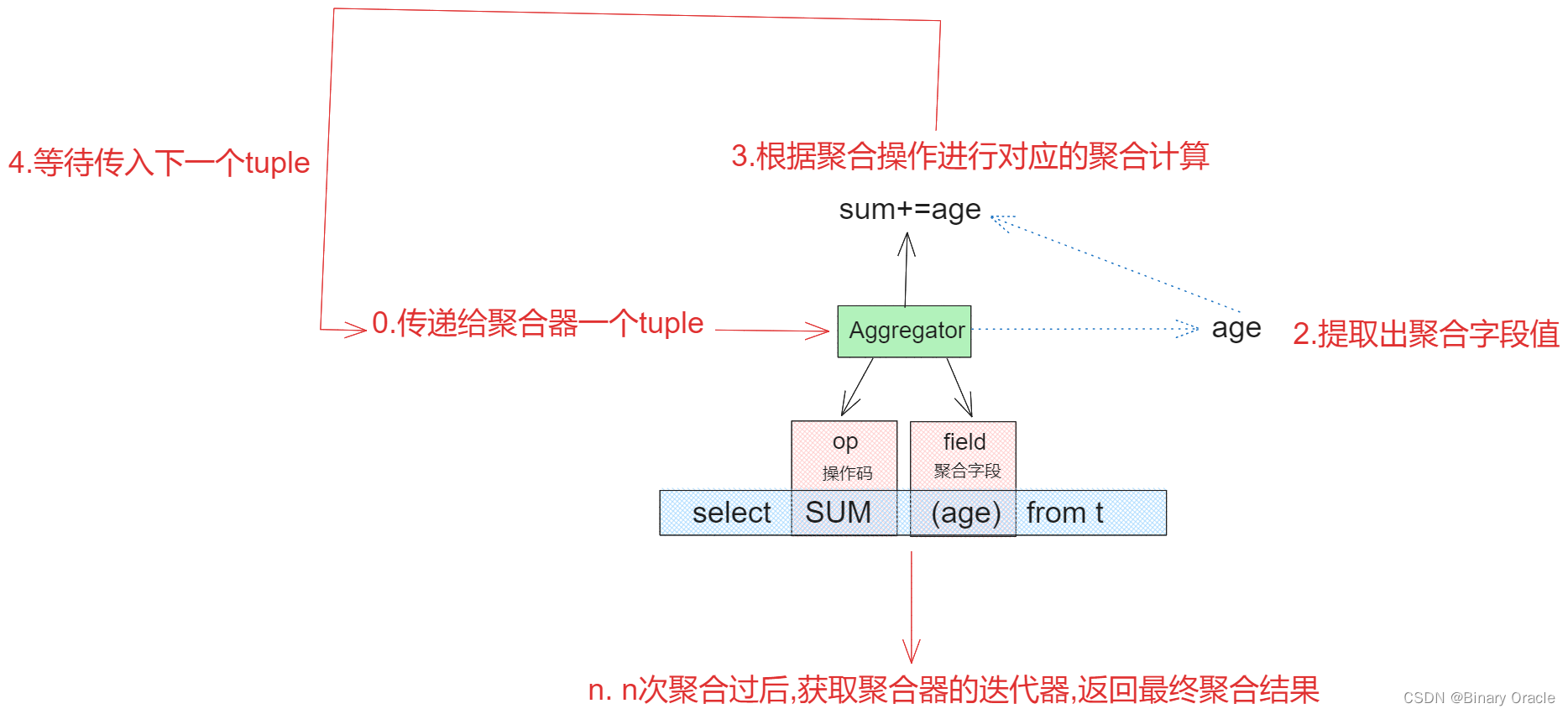
上面给出的是不涉及分组的聚合操作,如果涉及分组的话,聚合过程如下图所示:
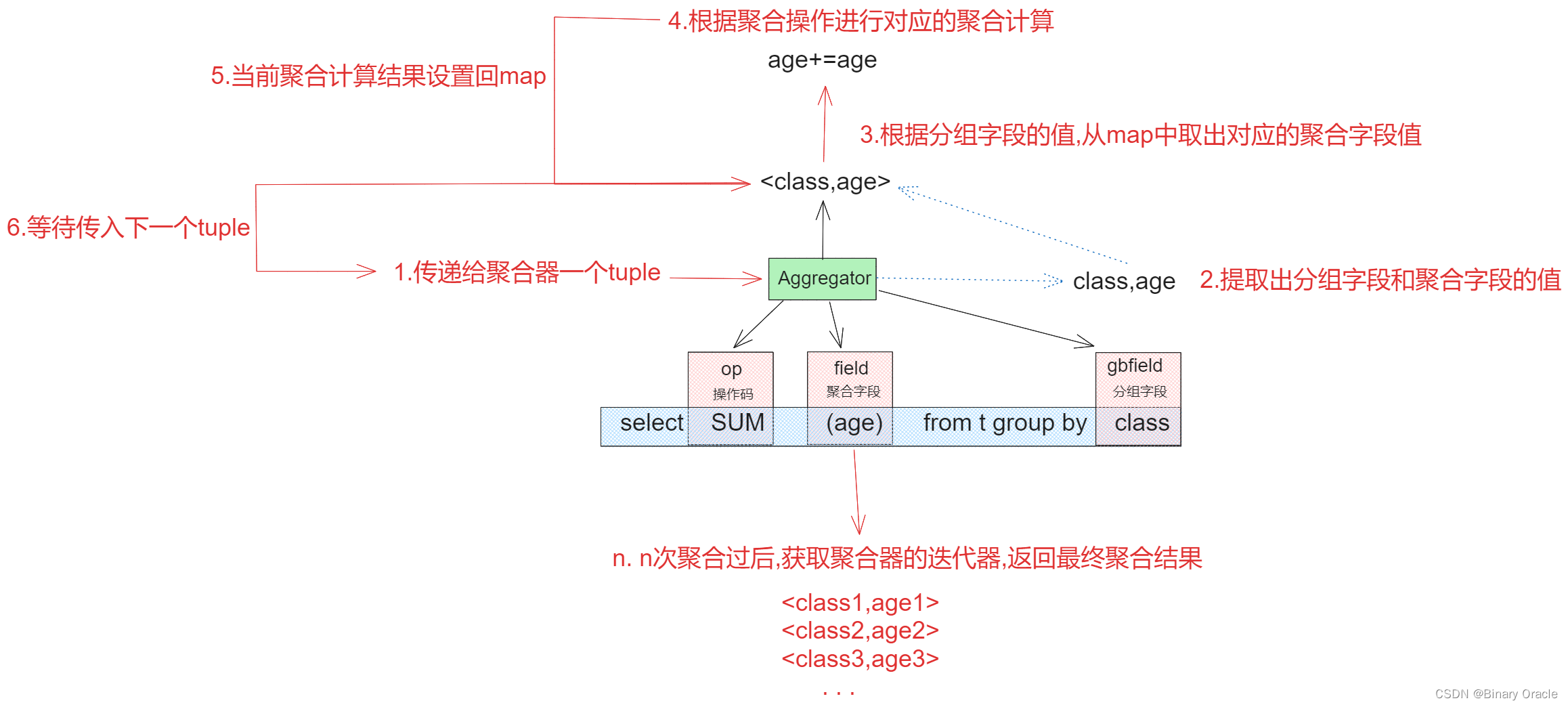
Aggregator聚合器接口定义如下:
/**
* The common interface for any class that can compute an aggregate over a
* list of Tuples.
*/
public interface Aggregator extends Serializable {
int NO_GROUPING = -1;
/**
* SUM_COUNT and SC_AVG will
* only be used in lab7, you are not required
* to implement them until then.
* */
enum Op implements Serializable {
MIN, MAX, SUM, AVG, COUNT,
/**
* SUM_COUNT: compute sum and count simultaneously, will be
* needed to compute distributed avg in lab7.
* */
SUM_COUNT,
/**
* SC_AVG: compute the avg of a set of SUM_COUNT tuples,
* will be used to compute distributed avg in lab7.
* */
SC_AVG;
...
}
/**
* Merge a new tuple into the aggregate for a distinct group value;
* creates a new group aggregate result if the group value has not yet
* been encountered.
*
* @param tup the Tuple containing an aggregate field and a group-by field
*/
void mergeTupleIntoGroup(Tuple tup);
/**
* Create a OpIterator over group aggregate results.
* @see TupleIterator for a possible helper
*/
OpIterator iterator();
}
对于不同类型字段的聚合有对应限制,比如: 字符串只支持COUNT统计个数聚合,不支持例如SUM,AVG等聚合操作。因此针对不兼容的类型,我们需要给出不同的聚合器实现:
- 首先来看比较简单的StringAggregator字符串聚合器,其只支持对COUNT聚合的操作
/**
* Knows how to compute some aggregate over a set of StringFields.
*/
public class StringAggregator implements Aggregator {
private static final IntField NO_GROUP = new IntField(-1);
/**
* 用于分组
*/
private int gbfield;
private Type gbfieldtype;
/**
* 用于聚合
*/
private int afield;
private Op what;
/**
* 存放结果-- 分组聚合返回的是多组键值对,分别代表分组字段不同值对应的聚合结果
* 非分组聚合只会返回一个聚合结果,这里为了统一化处理,采用NO_GROUP做标记,进行区分
*/
private Map<Field, Tuple> tupleMap;
private TupleDesc desc;
/**
* Aggregate constructor
*
* @param gbfield the 0-based index of the group-by field in the tuple, or NO_GROUPING if there is no grouping
* @param gbfieldtype the type of the group by field (e.g., Type.INT_TYPE), or null if there is no grouping
* @param afield the 0-based index of the aggregate field in the tuple
* @param what aggregation operator to use -- only supports COUNT
* @throws IllegalArgumentException if what != COUNT
*/
public StringAggregator(int gbfield, Type gbfieldtype, int afield, Op what) {
//字符串只支持COUNT聚合操作
if (!what.equals(Op.COUNT)) {
throw new IllegalArgumentException();
}
this.gbfield = gbfield;
this.gbfieldtype = gbfieldtype;
this.afield = afield;
this.what = what;
this.tupleMap = new ConcurrentHashMap<>();
//非分组聚合返回的结果采用占位符进行统一适配
if (gbfield == NO_GROUPING) {
this.desc = new TupleDesc(new Type[]{Type.INT_TYPE}, new String[]{"aggregateValue"});
Tuple tuple = new Tuple(desc);
tuple.setField(0, new IntField(0));
this.tupleMap.put(NO_GROUP, tuple);
} else {
//分组聚合返回结果Schema由两个字段组成: 分组字段和聚合结果
this.desc = new TupleDesc(new Type[]{gbfieldtype, Type.INT_TYPE}, new String[]{"groupValue", "aggregateValue"});
}
}
/**
* Merge a new tuple into the aggregate, grouping as indicated in the constructor
*
* @param tup the Tuple containing an aggregate field and a group-by field
*/
public void mergeTupleIntoGroup(Tuple tup) {
//只支持COUNT聚合
if (this.gbfield == NO_GROUPING) {
Tuple tuple = tupleMap.get(NO_GROUP);
IntField field = (IntField) tuple.getField(0);
tuple.setField(0, new IntField(field.getValue() + 1));
tupleMap.put(NO_GROUP, tuple);
} else {
Field field = tup.getField(gbfield);
if (!tupleMap.containsKey(field)) {
Tuple tuple = new Tuple(this.desc);
tuple.setField(0, field);
tuple.setField(1, new IntField(1));
tupleMap.put(field, tuple);
} else {
Tuple tuple = tupleMap.get(field);
IntField intField = (IntField) tuple.getField(1);
tuple.setField(1, new IntField(intField.getValue() + 1));
tupleMap.put(field, tuple);
}
}
}
/**
* Create a OpIterator over group aggregate results.
*/
public OpIterator iterator() {
return new StringIterator(this);
}
public class StringIterator implements OpIterator {
private StringAggregator aggregator;
private Iterator<Tuple> iterator;
public StringIterator(StringAggregator aggregator) {
this.aggregator = aggregator;
this.iterator = null;
}
@Override
public void open() throws DbException, TransactionAbortedException {
this.iterator = aggregator.tupleMap.values().iterator();
}
@Override
public boolean hasNext() throws DbException, TransactionAbortedException {
return iterator.hasNext();
}
@Override
public Tuple next() throws DbException, TransactionAbortedException, NoSuchElementException {
return iterator.next();
}
@Override
public void rewind() throws DbException, TransactionAbortedException {
iterator = aggregator.tupleMap.values().iterator();
}
@Override
public TupleDesc getTupleDesc() {
return aggregator.desc;
}
@Override
public void close() {
iterator = null;
}
}
...
}
- 其次来看稍微比较复杂的IntegerAggregator整数聚合器,其支持Op枚举中所有聚合操作
/**
* Knows how to compute some aggregate over a set of IntFields.
* <p/>
* 针对int字段进行聚合操作,聚合得到的结果需要是个整数
*/
public class IntegerAggregator implements Aggregator {
private static final long serialVersionUID = 1L;
private static final Field NO_GROUP = new IntField(-1);
/**
* 用于分组
*/
private int gbfield;
private Type gbfieldType;
/**
* 用于聚合
*/
private int afield;
private Op what;
/**
* 存放结果
*/
private TupleDesc tupleDesc;
private Map<Field, Tuple> aggregate;
/**
* 用于非分组情况下的聚合操作
*/
private int counts;
private int summary;
/**
* 用于分组情况下的聚合操作
*/
private Map<Field, Integer> countsMap;
private Map<Field, Integer> sumMap;
/**
* Aggregate constructor
*
* @param gbfield the 0-based index of the group-by field in the tuple, or
* NO_GROUPING if there is no grouping
* @param gbfieldtype the type of the group by field (e.g., Type.INT_TYPE), or null
* if there is no grouping
* @param afield the 0-based index of the aggregate field in the tuple
* @param what the aggregation operator
*/
public IntegerAggregator(int gbfield, Type gbfieldtype, int afield, Op what) {
//分组字段
this.gbfield = gbfield;
//分组字段类型
this.gbfieldType = gbfieldtype;
//聚合得到的结果,在聚合返回结果行中的字段下标
this.afield = afield;
//进行什么样的聚合操作
this.what = what;
//存放聚合结果
this.aggregate = new ConcurrentHashMap<>();
// 非分组聚合
if (gbfield == NO_GROUPING) {
this.tupleDesc = new TupleDesc(new Type[]{Type.INT_TYPE}, new String[]{"aggregateValue"});
Tuple tuple = new Tuple(tupleDesc);
//占位符
this.aggregate.put(NO_GROUP, tuple);
} else {
// 分组聚合,那么返回的聚合结果行由分组字段和该分组字段的聚合结果值组成
this.tupleDesc = new TupleDesc(new Type[]{gbfieldtype, Type.INT_TYPE}, new String[]{"groupValue", "aggregateValue"});
}
// 如果聚合操作是AVG,那么需要初始化count和summary变量,用于存放AVG聚合中间计算状态
if (gbfield == NO_GROUPING && what.equals(Op.AVG)) {
this.counts = 0;
this.summary = 0;
} else if (gbfield != NO_GROUPING && what.equals(Op.AVG)) {
this.countsMap = new ConcurrentHashMap<>();
this.sumMap = new ConcurrentHashMap<>();
}
}
/**
* Merge a new tuple into the aggregate, grouping as indicated in the
* constructor
* <p>
* 向整数聚合器中添加一行记录,进行分组计算
* @param tup the Tuple containing an aggregate field and a group-by field
*/
public void mergeTupleIntoGroup(Tuple tup) {
// 从传递给聚合器的行记录中取出聚合字段的值
IntField operationField = (IntField) tup.getField(afield);
if (operationField == null) {
return;
}
// 非分组聚合:
if (gbfield == NO_GROUPING) {
// 拿到承载聚合结果的元组对象
Tuple tuple = aggregate.get(NO_GROUP);
IntField field = (IntField) tuple.getField(0);
// 说明是进行聚合的第一行记录
if (field == null) {
// 如果聚合是统计个数操作
if (what.equals(Op.COUNT)) {
// 初值为1
tuple.setField(0, new IntField(1));
} else if (what.equals(Op.AVG)) {
// 如果聚合是求平均值操作
// 统计参与聚合的记录个数
counts++;
// 累加每个值
summary = operationField.getValue();
// 如果参与聚合的行只存在一个,那么平均值就是当前行的值
tuple.setField(0, operationField);
} else {
// 其他的情况: MIN,MAX,SUM在参与聚合的行只存在一个时,聚合结果就是当前行的值
// 所以这里可以统一处理
tuple.setField(0, operationField);
}
return;
}
// 判断是哪种类型的聚合
// 非第一行记录
switch (what) {
//select MIN(age) from t;
case MIN:
// 聚合字段的值和当前阶段已经保存的聚合结果进行比较,看谁更小
if (operationField.compare(Predicate.Op.LESS_THAN, field)) {
tuple.setField(0, operationField);
aggregate.put(NO_GROUP, tuple);
}
return;
//select MAX(age) from t;
case MAX:
// 聚合字段的值和当前阶段已经保存的聚合结果进行比较,看谁更大
if (operationField.compare(Predicate.Op.GREATER_THAN, field)) {
tuple.setField(0, operationField);
aggregate.put(NO_GROUP, tuple);
}
return;
//select COUNT(age) from t;
case COUNT:
// 计数+1
IntField count = new IntField(field.getValue() + 1);
tuple.setField(0, count);
aggregate.put(NO_GROUP, tuple);
return;
//select SUM(age) from t;
case SUM:
// 求和
IntField sum = new IntField(field.getValue() + operationField.getValue());
tuple.setField(0, sum);
aggregate.put(NO_GROUP, tuple);
return;
//select AVG(age) from t;
case AVG:
// 求平均值,每次往整数聚合器塞入一条记录时,都会将记录数和总和累加
counts++;
summary += operationField.getValue();
IntField avg = new IntField(summary / counts);
tuple.setField(0, avg);
aggregate.put(NO_GROUP, tuple);
return;
default:
return;
}
} else {
// 分组聚合操作:
// 获取分组字段 --> group by age
Field groupField = tup.getField(gbfield);
// 如果聚合结果中还不包括当前字段值,说明当前字段是第一次出现
// 例如: group by age --> <age=18,count=20> ,如果此次获取的age=20,那么就是第一次出现的分组值
if (!aggregate.containsKey(groupField)) {
Tuple value = new Tuple(this.tupleDesc);
value.setField(0, groupField);
if (what.equals(Op.COUNT)) {
value.setField(1, new IntField(1));
} else if (what.equals(Op.AVG)) {
countsMap.put(groupField, countsMap.getOrDefault(groupField, 0) + 1);
sumMap.put(groupField, sumMap.getOrDefault(groupField, 0) + operationField.getValue());
value.setField(1, operationField);
} else {
// 其他的情况: MIN,MAX,SUM在参与聚合的行只存在一个时,结果假设当前行的值
// 所以这里可以统一处理
value.setField(1, operationField);
}
aggregate.put(groupField, value);
return;
}
// 当前字段不是第一次出现的分组值
Tuple tuple = aggregate.get(groupField);
// 获取本阶段的聚合结果
IntField field = (IntField) tuple.getField(1);
switch (what) {
case MIN:
if (operationField.compare(Predicate.Op.LESS_THAN, field)) {
tuple.setField(1, operationField);
aggregate.put(groupField, tuple);
}
return;
case MAX:
if (operationField.compare(Predicate.Op.GREATER_THAN, field)) {
tuple.setField(1, operationField);
aggregate.put(groupField, tuple);
}
return;
case COUNT:
IntField count = new IntField(field.getValue() + 1);
tuple.setField(1, count);
aggregate.put(groupField, tuple);
return;
case SUM:
IntField sum = new IntField(field.getValue() + operationField.getValue());
tuple.setField(1, sum);
aggregate.put(groupField, tuple);
return;
case AVG:
countsMap.put(groupField, countsMap.getOrDefault(groupField, 0) + 1);
sumMap.put(groupField, sumMap.getOrDefault(groupField, 0) + operationField.getValue());
IntField avg = new IntField(sumMap.get(groupField) / countsMap.get(groupField));
tuple.setField(1, avg);
aggregate.put(groupField, tuple);
return;
default:
return;
}
}
}
public TupleDesc getTupleDesc() {
return tupleDesc;
}
/**
* Create a OpIterator over group aggregate results.
*
* @return a OpIterator whose tuples are the pair (groupVal, aggregateVal)
* if using group, or a single (aggregateVal) if no grouping. The
* aggregateVal is determined by the type of aggregate specified in
* the constructor.
*/
public OpIterator iterator() {
return new IntOpIterator(this);
}
public class IntOpIterator implements OpIterator {
private Iterator<Tuple> iterator;
private IntegerAggregator aggregator;
public IntOpIterator(IntegerAggregator aggregator) {
this.aggregator = aggregator;
this.iterator = null;
}
@Override
public void open() throws DbException, TransactionAbortedException {
this.iterator = aggregator.aggregate.values().iterator();
}
@Override
public boolean hasNext() throws DbException, TransactionAbortedException {
return iterator.hasNext();
}
@Override
public Tuple next() throws DbException, TransactionAbortedException, NoSuchElementException {
return iterator.next();
}
@Override
public void rewind() throws DbException, TransactionAbortedException {
iterator = aggregator.aggregate.values().iterator();
}
@Override
public TupleDesc getTupleDesc() {
return aggregator.tupleDesc;
}
@Override
public void close() {
iterator = null;
}
}
}
完成本节练习之后,需要通过PredicateTest, JoinPredicateTest, FilterTest, JoinTest单元测试;并通过FilterTest和JoinTest系统测试。
练习三 – HeapFile Mutability
本节我们将实现修改数据库表文件的方法,我们从单独的页面和文件开始,主要实现两种操作:增加元组和移除元组
- 移除元组:为了移除一个元组,我们需要实现
deleteTuple方法,元组包含RecordIDs可以帮助我们找到它们存储在哪一页,所以定位到元组对应的page并且正确修改page的headers信息就很简单了 - 增加元组:
HeapFile中的insertTuple方法主要用于向数据库文件添加一个元组。为了向HeapFile中添加一个新的元组,我们需要找到带有空槽的页,如果不存在这样的页,我们需要创造一个新页并且将其添加到磁盘的文件上。我们需要确保元组的RecordID被正确更新
实现如下类中的方法:
- src/java/simpledb/storage/HeapPage.java
- src/java/simpledb/storage/HeapFile.java (Note that you do not necessarily need to implement writePage at this point).
为了实现HeapPage,在insertTuple和deleteTuple方法中你需要修改表示header的bitmap;这里将会使用到我们在实验一中实现的getNumEmptySlots()和isSlotUsed方法,markSlotUsed方法是抽象方法,并且用于填充或者清除page header的的状态信息。
注意,insertTuple和deleteTuple方法需要通过BufferPool.getPage方法访问页,否则下一个实验中关于事务的实现将无法正常工作
HeapPage作为数据读写的最小单位,主要负责维护Page数据组织格式和数据读写操作,其内部属性如下所示:
public class HeapPage implements Page {
final HeapPageId pid;
final TupleDesc td;
final byte[] header;
final Tuple[] tuples;
final int numSlots;
byte[] oldData;
private final Byte oldDataLock = (byte) 0;
// 本lab新增的两个属性
private boolean dirty;
private TransactionId tid;
...
本节我们需要在HeapPage中实现的方法主要包括元组的插入,删除以及脏页标记和判脏:
/**
* Adds the specified tuple to the page; the tuple should be updated to reflect
* that it is now stored on this page.
*
* @param t The tuple to add.
* @throws DbException if the page is full (no empty slots) or tupledesc
* is mismatch.
*/
public void insertTuple(Tuple t) throws DbException {
TupleDesc tupleDesc = t.getTupleDesc();
if (getNumEmptySlots() == 0 || !tupleDesc.equals(this.td)) {
throw new DbException("this page is full or tupledesc is mismatch");
}
for (int i = 0; i < numSlots; i++) {
if (!isSlotUsed(i)) {
markSlotUsed(i, true);
t.setRecordId(new RecordId(this.pid, i));
tuples[i] = t;
break;
}
}
}
/**
* Delete the specified tuple from the page; the corresponding header bit should be updated to reflect
* that it is no longer stored on any page.
*
* @param t The tuple to delete
* @throws DbException if this tuple is not on this page, or tuple slot is
* already empty.
*/
public void deleteTuple(Tuple t) throws DbException {
RecordId recordId = t.getRecordId();
int slotId = recordId.getTupleNumber();
if (recordId.getPageId() != this.pid || !isSlotUsed(slotId)) {
throw new DbException("tuple is not in this page");
}
// 将tuple对应的slot置为0
markSlotUsed(slotId, false);
// 将slot对应的tuple置为null
tuples[slotId] = null;
}
/**
* Marks this page as dirty/not dirty and record that transaction
* that did the dirtying
*/
public void markDirty(boolean dirty, TransactionId tid) {
this.dirty = dirty;
this.tid = tid;
}
/**
* Returns the tid of the transaction that last dirtied this page, or null if the page is not dirty
*/
public TransactionId isDirty() {
return dirty ? tid : null;
}
其他辅助的工具方法大家自行查看源码
HeapFile可以看做是表的实体对象,表由一堆HeadPage组成,这一堆HeadPage存放于当前表的DBFile中,这里我们主要实现元组的插入和删除方法:
// see DbFile.java for javadocs
public List<Page> insertTuple(TransactionId tid, Tuple t)
throws DbException, IOException, TransactionAbortedException {
List<Page> modified = new ArrayList<>();
for (int i = 0; i < numPages(); i++) {
HeapPage page = (HeapPage) bufferPool.getPage(tid, new HeapPageId(this.getId(), i), Permissions.READ_WRITE);
if (page.getNumEmptySlots() == 0) {
continue;
}
page.insertTuple(t);
modified.add(page);
return modified;
}
// 当所有的页都满时,我们需要创建新的页并写入文件中
BufferedOutputStream outputStream = new BufferedOutputStream(new FileOutputStream(file, true));
byte[] emptyPageData = HeapPage.createEmptyPageData();
// 向文件末尾添加数据
outputStream.write(emptyPageData);
outputStream.close();
// 加载到缓存中,使用numPages() - 1是因为此时numPages()已经变为插入后的大小了
HeapPage page = (HeapPage) bufferPool.getPage(tid, new HeapPageId(getId(), numPages() - 1), Permissions.READ_WRITE);
page.insertTuple(t);
modified.add(page);
return modified;
}
// see DbFile.java for javadocs
public ArrayList<Page> deleteTuple(TransactionId tid, Tuple t) throws DbException,
TransactionAbortedException {
HeapPage page = (HeapPage) bufferPool.getPage(tid, t.getRecordId().getPageId(), Permissions.READ_WRITE);
page.deleteTuple(t);
ArrayList<Page> modified = new ArrayList<>();
modified.add(page);
return modified;
}
实现BufferPool类中的如下方法:
- insertTuple()
- deleteTuple()
这些方法需要调用需要被修改的表的HeapFile中的合适的方法来实现
public void insertTuple(TransactionId tid, int tableId, Tuple t)
throws DbException, IOException, TransactionAbortedException {
DbFile dbFile = Database.getCatalog().getDatabaseFile(tableId);
updateBufferPool(dbFile.insertTuple(tid, t), tid);
}
public void deleteTuple(TransactionId tid, Tuple t)
throws DbException, IOException, TransactionAbortedException {
DbFile dbFile = Database.getCatalog().getDatabaseFile(t.getRecordId().getPageId().getTableId());
updateBufferPool(dbFile.deleteTuple(tid, t), tid);
}
private void updateBufferPool(List<Page> pages, TransactionId tid) throws DbException {
for (Page page : pages) {
page.markDirty(true, tid);
}
}
完成练习后,我们的代码需要通过HeapPageWriteTest、HeapFileWriteTest和BufferPoolWriteTest单元测试
练习四 – Insertion & deletion
现在我们已经实现了向HeapFile添加和删除元组的机制,接下来就需要实现Insert和Delete操作
为了实现insert和delete查询,我们需要使用Insert和Delete来修改磁盘上的页,这些操作会返回被影响的元组数量
- Insert:该操作从他的子操作中读取元组加入到构造函数指定的tableid对应的表中,需要调用BufferPool.insertTuple()方法实现
- Delete:该操作从构造函数的tableid找到对应的table,并删除子操作中的元组,需要调用BufferPool.deleteTuple方法实现
实现如下类中的方法:
- src/java/simpledb/execution/Insert.java
- src/java/simpledb/execution/Delete.java
Insert和Delete采用的也是装饰器模式,所以这里不再多讲:
- Insert操作
/**
* Inserts tuples read from the child operator into the tableId specified in the
* constructor
*/
public class Insert extends Operator {
private static final long serialVersionUID = 1L;
private final TransactionId tid;
private OpIterator child;
private final int tableId;
private final TupleDesc tupleDesc;
private Tuple insertTuple;
/**
* Constructor.
*
* @param t The transaction running the insert.
* @param child The child operator from which to read tuples to be inserted.
* @param tableId The table in which to insert tuples.
* @throws DbException if TupleDesc of child differs from table into which we are to
* insert.
*/
public Insert(TransactionId t, OpIterator child, int tableId)
throws DbException {
this.tid = t;
this.child = child;
this.tableId = tableId;
this.tupleDesc = new TupleDesc(new Type[]{Type.INT_TYPE}, new String[]{"insertNums"});
this.insertTuple = null;
}
public TupleDesc getTupleDesc() {
return this.tupleDesc;
}
public void open() throws DbException, TransactionAbortedException {
super.open();
child.open();
}
public void close() {
super.close();
child.close();
}
public void rewind() throws DbException, TransactionAbortedException {
child.rewind();
}
/**
* Inserts tuples read from child into the tableId specified by the
* constructor. It returns a one field tuple containing the number of
* inserted records. Inserts should be passed through BufferPool. An
* instances of BufferPool is available via Database.getBufferPool(). Note
* that insert DOES NOT need check to see if a particular tuple is a
* duplicate before inserting it.
*
* @return A 1-field tuple containing the number of inserted records, or
* null if called more than once.
* @see Database#getBufferPool
* @see BufferPool#insertTuple
*/
protected Tuple fetchNext() throws TransactionAbortedException, DbException {
if (insertTuple != null) {
return null;
}
BufferPool bufferPool = Database.getBufferPool();
int insertTuples = 0;
while (child.hasNext()) {
try {
bufferPool.insertTuple(tid, tableId, child.next());
insertTuples++;
} catch (IOException e) {
e.printStackTrace();
}
}
//返回的是插入的元组数量
insertTuple = new Tuple(this.tupleDesc);
insertTuple.setField(0, new IntField(insertTuples));
return insertTuple;
}
@Override
public OpIterator[] getChildren() {
return new OpIterator[]{child};
}
@Override
public void setChildren(OpIterator[] children) {
this.child = children[0];
}
}
此处的装饰器模式并非等同于传统意义上的,例如此处的fetchNext会返回符合当前操作含义的结果,filter操作返回满足条件的Tuple,Insert操作返回插入的记录数。
- delete操作
/**
* The delete operator. Delete reads tuples from its child operator and removes
* them from the table they belong to.
*/
public class Delete extends Operator {
private static final long serialVersionUID = 1L;
private final TransactionId tid;
private OpIterator child;
private final TupleDesc tupleDesc;
private Tuple deleteTuple;
/**
* Constructor specifying the transaction that this delete belongs to as
* well as the child to read from.
*
* @param t The transaction this delete runs in
* @param child The child operator from which to read tuples for deletion
*/
public Delete(TransactionId t, OpIterator child) {
this.tid = t;
this.child = child;
this.tupleDesc = new TupleDesc(new Type[]{Type.INT_TYPE}, new String[]{"deleteNums"});
this.deleteTuple = null;
}
public TupleDesc getTupleDesc() {
return this.tupleDesc;
}
public void open() throws DbException, TransactionAbortedException {
super.open();
child.open();
}
public void close() {
super.close();
child.close();
}
public void rewind() throws DbException, TransactionAbortedException {
child.rewind();
}
/**
* Deletes tuples as they are read from the child operator. Deletes are
* processed via the buffer pool (which can be accessed via the
* Database.getBufferPool() method.
*
* @return A 1-field tuple containing the number of deleted records.
* @see Database#getBufferPool
* @see BufferPool#deleteTuple
*/
protected Tuple fetchNext() throws TransactionAbortedException, DbException {
if (deleteTuple != null) {
return null;
}
BufferPool bufferPool = Database.getBufferPool();
int deleteNums = 0;
while (child.hasNext()) {
try {
bufferPool.deleteTuple(tid, child.next());
deleteNums++;
} catch (IOException e) {
e.printStackTrace();
}
}
deleteTuple = new Tuple(tupleDesc);
deleteTuple.setField(0, new IntField(deleteNums));
return deleteTuple;
}
@Override
public OpIterator[] getChildren() {
return new OpIterator[]{child};
}
@Override
public void setChildren(OpIterator[] children) {
this.child = children[0];
}
}
完成实验后需要通过InsertTest单元测试,并且通过InsertTest和DeleteTest系统测试
练习五 – Page eviction
在实验一中,我们没有正确的根据BufferPool构造函数中定义的numPages对BufferPool中缓存的最大页面数量进行限制,本节我们将实现拒绝策略。
当缓冲池中存在超过numPages数量的页时,我们需要在加载下一个页时选择淘汰缓冲池中现存的一个页;具体的拒绝策略我们自己选择即可。
BufferPool中包含一个flushAllPages方法,该方法不会被实际用到,只是用来进行实际的测试,我们在实际代码中不会调用此方法。
flushAllPages方法需要调用flushPage方法,并且flushPage方法需要在page离开BufferPool时将脏页写入磁盘,并且将其置为非脏。
从缓冲池中移除页面的唯一方法是evictPage,当任何脏页被丢弃时,我们需要调用flushPage方法来将其刷新到磁盘。
如果学过操作系统,那么应该了解过缓存页面丢弃策略,主要有先进先出(FIFO)、最近最少使用(LRU)和最不常用(LFU)这几种方法,我们可以选择不同的策略实现。我这里给定了一个抽象的接口,定义好方法,最后实现了FIFO和LRU页面丢弃策略,详情请看代码。
实现BufferPool的页面丢弃策略:
- src/java/simpledb/storage/BufferPool.java
我们需要实现discardPage方法去移除缓冲池中没有被刷新到磁盘上的页,本次实验不会使用该方法,但是它是未来的实验所必须的。
页面淘汰采用策略模式进行实现,这里只展示FIFO策略的实现,LRU可以采用哈希链表实现,具体可以参考Lab2源代码中的LRUEvict类:
public interface EvictStrategy {
/**
* 修改对应的数据结构以满足丢弃策略
* @param pageId
*/
void addPage(PageId pageId);
/**
* 获取要丢弃的Page的PageId信息,用于丢弃
* @return PageId
*/
PageId getEvictPageId();
}
public class FIFOEvict implements EvictStrategy {
/**
* 存储数据的队列
*/
private final Queue<PageId> queue;
public FIFOEvict(int numPages) {
this.queue = new ArrayDeque<>(numPages);
}
@Override
public void addPage(PageId pageId) {
// 向尾部插入元素
boolean offer = queue.offer(pageId);
if (offer) {
System.out.println("PageId: " + pageId + " 插入队列成功");
} else {
System.out.println("PageId: " + pageId + " 插入队列失败");
}
}
@Override
public PageId getEvictPageId() {
// 从队列头部获取元素
return queue.poll();
}
}
借助淘汰策略接口和实现类,完成BufferPool中关于flushPage和evitPage相关方法:
private final EvictStrategy evict;
public BufferPool(int numPages) {
this.numPages = numPages;
this.pageCache = new ConcurrentHashMap<>();
this.evict = new FIFOEvict(numPages);
}
/**
* Flush all dirty pages to disk.
* NB: Be careful using this routine -- it writes dirty data to disk so will
* break simpledb if running in NO STEAL mode.
*/
public synchronized void flushAllPages() throws IOException {
pageCache.forEach((pageId, page) -> {
try {
flushPage(pageId);
} catch (IOException e) {
e.printStackTrace();
}
});
}
/**
* Remove the specific page id from the buffer pool.
* Needed by the recovery manager to ensure that the
* buffer pool doesn't keep a rolled back page in its
* cache.
* <p>
* Also used by B+ tree files to ensure that deleted pages
* are removed from the cache so they can be reused safely
*/
public synchronized void discardPage(PageId pid) {
pageCache.remove(pid);
}
/**
* Flushes a certain page to disk
*
* @param pid an ID indicating the page to flush
*/
private synchronized void flushPage(PageId pid) throws IOException {
Page flush = pageCache.get(pid);
// 通过tableId找到对应的DbFile,并将page写入到对应的DbFile中
int tableId = pid.getTableId();
DbFile dbFile = Database.getCatalog().getDatabaseFile(tableId);
// 将page刷新到磁盘
dbFile.writePage(flush);
}
/**
* Discards a page from the buffer pool.
* Flushes the page to disk to ensure dirty pages are updated on disk.
*/
private synchronized void evictPage() throws DbException {
PageId evictPageId = evict.getEvictPageId();
try {
flushPage(evictPageId);
} catch (IOException e) {
e.printStackTrace();
}
pageCache.remove(evictPageId);
}
public Page getPage(TransactionId tid, PageId pid, Permissions perm)
throws TransactionAbortedException, DbException {
if (!pageCache.containsKey(pid)) {
if (pageCache.size() > numPages) {
evictPage();
}
DbFile dbFile = Database.getCatalog().getDatabaseFile(pid.getTableId());
Page page = dbFile.readPage(pid);
pageCache.put(pid, page);
evict.addPage(pid);
}
return pageCache.get(pid);
}
完成练习之后,代码需要通过EvictionTest单元测试。
至此我们就完成本次实验了,接下来还有对实验内容的其他测试。
练习六 – Query walkthrough
通过我们实现的各种查询策略,来执行类似于下面SQL语句的联合查询:
SELECT *
FROM some_data_file1,
some_data_file2
WHERE some_data_file1.field1 = some_data_file2.field1
AND some_data_file1.id > 1
我们需要根据实验一中的方法创建两个数据库文件some_data_file1.dat和some_data_file2.dat,然后使用如下代码进行测试:

运行下面这个测试,可以得到2,2,3,3,2,4和3,3,4,5,3,7两条结果:
public class JoinTest {
/**
* select * from t1,t2 where t1.f0 > 1 and t1.f1 = t2.f1 ;
*/
public static void main (String[] args) {
// construct a 3-column table schema
Type[] types = new Type[]{Type.INT_TYPE, Type.INT_TYPE, Type.INT_TYPE};
String[] names = new String[]{"f0", "f1", "f2"};
TupleDesc td = new TupleDesc(types, names);
// create the tables, associate them with the data files
// and tell the catalog about the schema the tables.
HeapFile table1 = new HeapFile(new File("some_data_file1.dat"), td);
Database.getCatalog().addTable(table1, "t1");
HeapFile table2 = new HeapFile(new File("some_data_file2.dat"), td);
Database.getCatalog().addTable(table2, "t2");
// construct the query: we use two SeqScans, which spoonfeed
// tuples via iterators into join
TransactionId tid = new TransactionId();
SeqScan ss1 = new SeqScan(tid, table1.getId(), "t1");
SeqScan ss2 = new SeqScan(tid, table2.getId(), "t2");
// create a filter for the where condition
Filter sf1 = new Filter(
new Predicate(0,
Predicate.Op.GREATER_THAN, new IntField(1)), ss1);
JoinPredicate p = new JoinPredicate(1, Predicate.Op.EQUALS, 1);
Join j = new Join(p, sf1, ss2);
// and run it
try {
j.open();
while (j.hasNext()) {
Tuple tup = j.next();
System.out.println(tup);
}
j.close();
Database.getBufferPool().transactionComplete(tid);
} catch (Exception e) {
e.printStackTrace();
}
}
}

练习七 - 查询解析
本节我们将会使用SimpleDB中已经编写好的SQL解析器来实现基于SQL语句的查询
首先我们需要创建数据库表和数据库目录,其中数据库表data.txt的内容如下:
1,10
2,20
3,30
4,40
5,50
5,50
通过如下命令将其转换为二进制文件:
java -jar dist/simpledb.jar convert data.txt 2 "int,int"
接下来创建数据库目录文件catalog.txt:
data (f1 int, f2 int)
该文件会告诉SimpleDB数据库中包含一个表:data,其结构为两个int类型的列
最后,我们运行如下命令:
java -jar dist/simpledb.jar parser catalog.txt
可以看到如下输出:
Added table : data with schema INT_TYPE(f1), INT_TYPE(f2)
Computing table stats.
Done.
SimpleDB>
接着输入SQL语句即可进行查询:
SimpleDB> select d.f1, d.f2 from data d;
Started a new transaction tid = 0
Added scan of table d
Added select list field d.f1
Added select list field d.f2
The query plan is:
π(d.f1,d.f2),card:0
|
scan(data d)
d.f1 d.f2
------------------
1 10
2 20
3 30
4 40
5 50
5 50
6 rows.
Transaction 0 committed.
----------------
0.10 seconds
如果没有报错的话,证明你的相关实现都是正确的
